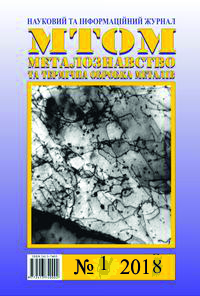The modeling by final elements method of temperature change in the rim cross-section during heat treatment of railway wheels made from different chemical composition steels
DOI:
https://doi.org/10.30838/J.PMHTM.2413.240418.10.99Keywords:
railroad wheel, heat treatment, phase transformation, thermokinetic diagram, modeling with finite element method, chemical microinhomogeneity of steel, carbon steels for railway wheelsAbstract
Formulation of the problem. The achievement of high mechanical properties of the railway wheel rim made from carbon steel is ensured by the highly dispersed perlite structure formation in it and a small amount of pre-eutectoid ferrite, which is allocated in the form of a grid along the borders of the former austenitic grains. Microstructural studies of the wheel rims show that the existing modes of heat treatment in some cases lead, along with ferrite and perlite, to the formation of the structure of bainite in places where chemical microinhomogeneity may occur and a fairly high cooling rate can be realized. As a decision of this problem can be used application of the flexible control systems of thermal processing, based on the simulation of processes of phase and structural transformations. Method. The accelerated cooling of the railway wheel rim during its heat treatment was simulated by means of the finite element method using the thermal conductivity equation (Fourier equation). When simulation the steel was used with marginal deviations of a chemical composition within the normative documentation requirements that can take place in the wheel rim metal as a result of the chemical elements segregation during the dendritic crystallization of the workpiece. The carbon steel which is used for producing the railway wheels, mainly differ only in the content of carbon, manganese and silicon. In practice, the range of these elements changes in the wheel steel of various grades in the impoverished and enriched with chemical elements segregation sites formed during crystallization can be: 0.45…0.70 % carbon; 0.25…0.50 % silicon; 0.40…1.0 % manganese. Results. It is shown that when cooling the rim of a railway wheel in its inner layers, a lower cooling rate is realized, that is, phase transformations with a change of the distance from the heat removal surface during heat treatment pass in other conditions. It has been proved that at the early stages of accelerated cooling it is necessary to reduce the intensity of water flow so that the cooling rate does not exceed the critical one. Scientific novelty. The regularities of a temperature change in the cross-section of the railway wheel rim from the different chemical composition steels during the process of accelerated cooling with the hardening heat treatment were established. Practical significance. The developed models will allow to develop scientifically substantiated heat treatment modes of railroad wheels in order to ensure the formation of a uniform fine dispersed microstructure in the cross-section of the rail wheel rim.References
Бабаченко А. И. Разработка режимов охлаждения железнодорожного колеса на вертикальной закалочной машине с помощью математической модели расчета скоростей охлаждения / А. И. Бабаченко, А. А. Кононенко, М. А. Дедик // Сучасні проблеми металургії. − 2017. − № 20. − С. 14−21. – Режим доступу : http://spm.nmetau.edu.ua/uk/journal
Бабаченко О. І. Визначення оптимальної швидкості охолодження при термічній обробці залізничних рейок /
О. І. Бабаченко, О. В. Узлов, О. В. Пучіков, А. М. Хулін, Г. А. Кононенко // Проблеми і перспективи розвитку залізничного транспорту: наук. пр. 77-ї Міжнар. наук.-практ. конф. − 2017. − С. 302−304. − Режим доступу: http://webcache.googleusercontent.com/search?q=cache:oqwR7zqQ8E4J:ndch.diit.edu.ua/upload/%25D0%25BF%25D1%2580%25D0%25BE%25D0%25B3%25D1%2580%25D0%25B0%25D0%25BC%25D0%25BC%25D0%25B0%252077%2520%25D0%25BA%25D0%25BE%25D0%25BD%25D1%2584.%2B.pdf+&cd=3&hl=ru&ct=clnk&gl=ua&client=firefox-b-ab
Бабаченко О. І. Розробка математичної моделі розрахунку температурного поля по перетину залізничної рейки при термічній обробці / О. І. Бабаченко, Г. А. Кононенко, Н. Ю. Філоненко, А. М. Хулін // Будівництво. Матеріалознавство. Машинобудування. − Вип. 104. − Дніпро: ДВНЗ ПДАБА, 2018. − С. 31−35.
Лахтин Ю. М. Материаловедение и термическая обработка металлов : монография / Ю. М. Лахтин. – Москва : Металлургия, 1983. – 359 с.
Диаграммы превращения аустенита в сталях и бета-раствора титана : справочник термиста / [Л. Е. Попова,
А. А. Попов]. – Москва : Металлургия, 1991. – 503 с.
Энтин Р. И. Превращения аустенита в стали : монография / Р. И. Энтин – Москва : Гос. науч.-техн. изд-во лит-ры по черной и цветной металлургии, 1960. – 252 с.
Downloads
Published
Issue
Section
License
Authors that are published in this journal agree to follow the conditions:
Authors reserve the right to the authorship of his work and cede the right to the journal of first publication of this work on conditions of the license under the Creative Commons Attribution License, which allows others to distribute it freely with the obligatory reference to the author of the original work and the first publication of the work in this journal.

